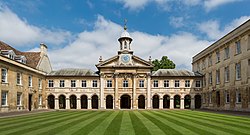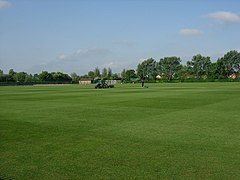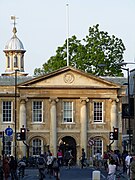Difference between revisions of "Emmanuel College, Cambridge"
(Created page with "{{Infobox college |name=Emmanuel College |latin=Collegium Emanuelis |county=Cambridgeshire |university=Cambridge |picture=Emmanuel College Front Court, Cambridge, UK - Diliff....") |
(No difference)
|
Latest revision as of 22:00, 31 March 2024
| Emmanuel College Latin: Collegium Emanuelis
| |||||||||||
 Front Court, Emmanuel College | |||||||||||
|---|---|---|---|---|---|---|---|---|---|---|---|
| Master: | Douglas Chalmers | ||||||||||
| Website: | emma.cam.ac.uk | ||||||||||
| |||||||||||
| Location | |||||||||||
| Grid reference: | TL45275829 | ||||||||||
| Location: | 52°12’13"N, 0°7’28"E | ||||||||||
Emmanuel College is a constituent college of the University of Cambridge. The college was founded in 1584 by Sir Walter Mildmay, Chancellor of the Exchequer to Elizabeth I.[1] The site on which the college sits was once a priory for Dominican monks, and the College Hall is built on the foundations of the monastery's nave. Emmanuel is one of the 16 "old colleges", which were founded before the 17th century.
Today, Emmanuel is one of the larger Cambridge colleges; it has around 500 undergraduates, reading almost every subject taught within the University, and around 200 postgraduates.[2]
In every year from 1998 until 2016, Emmanuel was among the top five colleges in the Tompkins Table, which ranks colleges according to end-of-year examination results. Emmanuel topped the table five times (2003, 2004, 2006, 2007 and 2010) and placed second six times (2001, 2002, 2008, 2009, 2011 and 2012). Its mean score for 1997–2018 inclusive places it as the second-highest-ranking college after Trinity.
History
The college was founded in 1584 by Sir Walter Mildmay, Chancellor of the Exchequer to Elizabeth I.[1] The site had been occupied by a Dominican friary until the Dissolution of the Monasteries 45 years earlier, after which the Vice-Chancellor petitioned that the place be given over to the University; his request was refused. After passing through several hands, the former monastery was purchased for £550 to be the site of the new college in June 1583 by Laurence Chaderton, the Master-elect, and his brother-in-law, Richard Culverwell, acting on behalf of Mildmay, to whom they conveyed the property on 23 November 1582.[3] Mildmay's foundation made use of the existing buildings. The architect was Ralph Symons, and in 1588 the new building was opened with a dedication festival, which Mildmay attended.
Mildmay, a Puritan, intended Emmanuel to be a centre for the training of Anglican preachers. According to Thomas Fuller, Mildmay, on coming to court after the college was opened, was addressed by the Queen with the words: "Sir Walter, I hear you have erected a puritan foundation", to which Mildmay replied: "No, madam; far be it from me to countenance anything contrary to your established laws; but I have set an acorn, which when it becomes an oak, God alone knows what will be the fruit thereof".[4]
Like all the older Cambridge colleges, Emmanuel originally took only male students. It first admitted female students in 1979.[5]
Buildings and grounds
Under Mildmay's instructions the chapel of the original Dominican Friary was converted into the College's dining hall and the friars' dining hall became a chapel. In the late 17th century the College commissioned a new chapel, one of the three buildings in Cambridge designed by Christopher Wren (1677). After Wren's construction was opened the old chapel became the College library until it outgrew the space. The library moved to its present space in 1930, occupying a large building in South Court completed in 1911 and initially used as lecture rooms.[6] The library was extended in 1974.[7]
There is a large fish pond in the grounds, part of the legacy of the friary. The pond is home to a colony of ducks.
The Fellows' Garden contains a swimming pool that was the friars' bathing pool, making it one of the oldest bathing pools in Europe and allegedly the oldest outdoor pool in continuous use in the UK. The Garden also contains an Oriental plane tree that is reputed to have lived far longer than is typical for the species.[8]
It has been claimed that the college has the only privately owned subway (underpass) in the United Kingdom, connecting the main site to North Court, but in fact Oriel College, Oxford, has its own tunnel beneath Oriel Street linking the Island Site with the main college buildings.[9] The Bodleian Library in Oxford also has its own tunnel beneath Broad Street.
Queen's Building
The Queen's Building encompasses a 150-seat theatre, reception and seminar rooms, and facilities for music practice. The theatre inside the Queen's Building is frequently utilized by the College for various purposes, such as lectures, Music Society concerts, admissions open day talks, and is a conference venue. Designed by the architects Sir Michael and Patty Hopkins, the Queen's Building is constructed using Ketton stone. The architectural design combines the robustness of the stone exterior walls with the spanning capabilities and mass of concrete for the floors. The limestone exterior is load bearing, and is the first building to use post-tensioned stone with internal cables. The roof is adorned with lead, and American white oak is extensively incorporated into the roof and panelling. The building was inaugurated in 1995.
Outside links
| ("Wikimedia Commons" has material about Emmanuel College, Cambridge) |
- Emmanuel College
- Emmanuel College May Ball website
- Emmanuel College Middle Combination Room (MCR)
- Emmanuel College Students' Union
References
- ↑ 1.0 1.1 Bendall, Sarah; Brooke, Christopher; Collinson, Patrick (1999). A History of Emmanuel College, Cambridge. Boydell Press. ISBN 0-85115-393-3.
- ↑ "History of the College | History & Archives | About | Emmanuel College, Cambridge". https://www.emma.cam.ac.uk/about/history/college/.
- ↑ A History of the County of Cambridgeshire - Volume 3 pp 474-480: The colleges and halls: Emmanuel (Victoria County History)
- ↑ Lee, Sidney (1894). "Mildmay, Walter". in Lee, Sidney. Dictionary of National Biography, 1885–1900. 37. London: Smith, Elder & Co.. pp. 388–390.:389
- ↑ "History of the College". Emmanuel College. https://www.emma.cam.ac.uk/about/history/college/.
- ↑ "Emmanuel College: Library". Cambridge 2000. http://www.cambridge2000.com/cambridge2000/html/0009/P9042356.html.
- ↑ "Emmanuel College: Library extension". Cambridge 2000. https://www.cambridge2000.com/cambridge2000/html/0009/P9062419.html.
- ↑ Gray, Ron. "The Great Oriental Plane Tree at Emmanuel College". Emmanuel College, Cambridge. http://www.emma.cam.ac.uk/about/discover/plane/.
- ↑ http://www.oriel.ox.ac.uk main site accessibility map 2019.pdf
| Colleges of the University of Cambridge | |
|---|---|
|
Christ’s • Churchill • Clare • Clare Hall • Corpus Christi • Darwin • Downing • Emmanuel • Fitzwilliam • Girton • Gonville and Caius • Homerton • Hughes Hall • Jesus • King’s • Lucy Cavendish • Magdalene • Murray Edwards • Newnham • Pembroke • Peterhouse • Queens’ • Robinson • St Catharine’s • St Edmund’s • St John’s • Selwyn • Sidney Sussex • Trinity • Trinity Hall • Wolfson |
|






